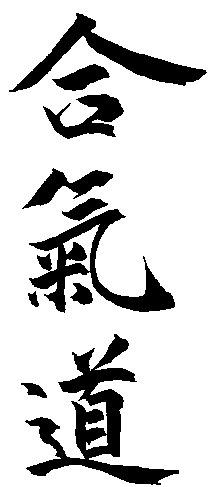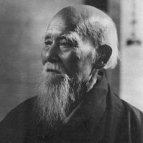Why
Learn Aikido?
A Beginnner's View of Aikido
 Aikido
is a relatively new self-defensive art, founded in Japan by Professor
Morihei
Ueshiba (1883-1969). As a youth, Ueshiba Sensei, or O-Sensei (Great
Teacher)
as he was called, applied himself to many years of intense training in
budo, or the Japanese martial arts. He was a master of Jiu-jitsu, the
spear,
and the staff, and was considered unbeatable with the sword. O'Sensei
also
delved deeply into religion and the meaning of life, studying Zen
Buddhism
and Shinto. Although he became very strong and won many challenges,
Ueshiba
Sensei was troubled with the idea that winning at someone else's
expense
was not true victory. Though he was an acknowledged master, he began to
study movement and technique even more intensely, and he eventually
came
to realize that true self-defense was not winning over others, but
winning
over the discord within oneself.
Aikido
is a relatively new self-defensive art, founded in Japan by Professor
Morihei
Ueshiba (1883-1969). As a youth, Ueshiba Sensei, or O-Sensei (Great
Teacher)
as he was called, applied himself to many years of intense training in
budo, or the Japanese martial arts. He was a master of Jiu-jitsu, the
spear,
and the staff, and was considered unbeatable with the sword. O'Sensei
also
delved deeply into religion and the meaning of life, studying Zen
Buddhism
and Shinto. Although he became very strong and won many challenges,
Ueshiba
Sensei was troubled with the idea that winning at someone else's
expense
was not true victory. Though he was an acknowledged master, he began to
study movement and technique even more intensely, and he eventually
came
to realize that true self-defense was not winning over others, but
winning
over the discord within oneself.
 The
word Aikido in Japanese is made up of three kanji (characters).
"AI" means "to meet, to come together, to harmonize"; "KI" means
"energy,
spirit, mind" (in a larger context "KI" means "the spirit" or "the
nature"
or "of the universe," and not just the spirit of human beings). "DO"
means
"the Way" which signifies that the study of Aikido does not involve
merely
self-defense techniques but includes positive character-building ideals
which a person can incorporate into his or her own life. AIKIDO
therefore
means the way of harmonizing with the spirit of the universe.
The
word Aikido in Japanese is made up of three kanji (characters).
"AI" means "to meet, to come together, to harmonize"; "KI" means
"energy,
spirit, mind" (in a larger context "KI" means "the spirit" or "the
nature"
or "of the universe," and not just the spirit of human beings). "DO"
means
"the Way" which signifies that the study of Aikido does not involve
merely
self-defense techniques but includes positive character-building ideals
which a person can incorporate into his or her own life. AIKIDO
therefore
means the way of harmonizing with the spirit of the universe.
Why Learn
Aikido?
By Kim
Riddick, 1st
Dan: Instructor SFU Aikikai
SFU has many martial arts clubs, but to someone who has never tried
a martial art, the choices can be almost overwhelming. Each martial art
offers a distinct history and philosophy as well as physical
techniques.
Aikido is one of these martial arts.
The word Ai-Ki-Do
means the way of harmony with the universal spirit and energy. It is a
physical and spiritual discipline taking the form of a martial art.
Aikido
is more than simply a system of self-defense; it promotes peace and
harmony
amongst people.
To
understand a little
more about Aikido, it is necessary to know something about the life of
Master Ueshiba, Aikido's founder. He devoted his life to martial arts.
However as he learned some of the most sophisticated and devastating
fighting
techniques of Japan, he found himself questioning their values -
aggression,
physical force, the need to defeat others. In his spiritual pursuit of
the true martial art, Master Ueshiba was profoundly inspired by Shinto,
an ancient Japanese religion based on love and harmony with nature.
After
many years
of studying the martial arts and reflection, Master Ueshiba concluded
that
love is the essence of the universe. Furthermore, martial art training
must consist of nourishing the love of God and one's being. From these
philosophical tenets, he adapted the techniques of jujitsu and the
Japanese
sword into a universal system where all movements reflect this
philosophy.
Through
training,
the Aikido practitioner becomes stronger, but more gentle, more alert,
but more intuitive, more solid, but more harmonious. Without adversial
relationships, Aikido unifies opposing forces in unresisting harmony.
The
students learns to hold himself stable but mobile, this centre of
gravity
low and to breathe naturally.
During
practice,
the student marries his movements to those of others. He avoids
collisions
and conflicts, and directs others' energy so that it reinforces his
own.
The techniques include falls, immobilization of the joints of both the
left and right sides. The complexity and the intensity of practice
varies
with experience.
In
Aikido, there
are no tournaments, no winners and no losers. It provides a medium in
which
students can discover his or her own strengths and weaknesses. As he or
she masters the art, he or she masters himself or herself. In this way,
Aikido, the way of harmonious energy, reaches out from the practice
hall
to enrich our lives and the lives of those around us.
Choosing
a martial
art is a personal choice. Hence, I encourage anyone who is interested
in
a martial art to observe or experience a class offered by the different
clubs on campus. As an Aikido instructor, my goal is not only to teach
techniques, but also to provide a safe, enjoyable, and non-competitive
environment where people can practice. Through training, I essentially
hope my students acquire an awareness of their bodies, learn to relax,
and eventually obtain greater control of their bodies. The dojo is also
a place to share my enthusiasm for Aikido.
Kim
Riddick, 1st
degree blackbelt, and has practised Aikido for nine years and
instructed
Aikido at SFU for four years.
A Beginnner's
View of Aikido
By Nigel
Fogden
I
remember how awkward I felt at my first Aikido class. The instructor
would
demonstrate a technique that would seem more like a tornado of movement
than anything I could ever do. Or sometimes the teacher would show
things
down and make one simple but fluid movement. "Ah ha!" I would think, "I
can do that." Much to my surprise however, I found that I couldn't even
turn around correctly. There were a couple of other beginners who
started
at the same time as I did and they were stumbling along with the same
awkwardness
as I was. But other than our little group of beginners, everybody else
seemed to know what they were doing. It was frustrating and very
humbling.
Yet for
all of the
frustration I stayed with it. I saw something in Aikido that I had not
seen anywhere else. I had started because I was looking to get in shape
and try something new. This however was something different entirely.
Far
from being a way to hurt people, Aikido seemed like the essence of
peace
in motion. In its spirals and circles, it resolved aggression into
harmony
in a powerfully physical way. This was not just a philosophy or a
collection
of pleasant words. The challenge I saw in Aikido was the challenge to
meet
physical force with understanding and grace. What aikido was and is to
me is an example of the true strength of peace.
To begin
learning
Aikido I had to re-learn how to learn. It seems strange to say that I
would
need to re-learn how to learn, after a life filled with "education",
but
in spite of all the books I had read and classes I had taken it had
been
along time since I had started anything from scratch. Starting as a
complete
beginner was both frustrating and liberating. It was hard to
acknowledge
how much I had to learn, but it was wonderful to allow myself to make
mistakes.
I first had to accept how much I did not know before I could begin to
learn.
There are
different
ways to learn. I have spent most of my life learning with my mind but
Aikido
taught me that another one of those ways is to learn with your body.
Now
to a dancer or a boxer, this is probably no surprise, but to me it was
a revelation. Skill in Aikido, like that of dance, is not something you
can gain through reading. Aikido can only be learned through practice
and
experience.
The
training hall,
or dojo, can be the laboratory. It is a place where I try to leave my
stress,
my fear, as well as the sense of my own importance at the door. This is
crucial because Aikido is a martial art and because of this it deals
with
life and death. Aikido demands focus. But through dedication and focus
a kind of alchemy occurs. Through Aikido we are taught how to transmute
force into peace and violence into harmony.
Nigel
Fogden,
5th kyu, has practiced Aikido for a year.
Page
updated Mar. 4, 2007 by Glenn Chapman






